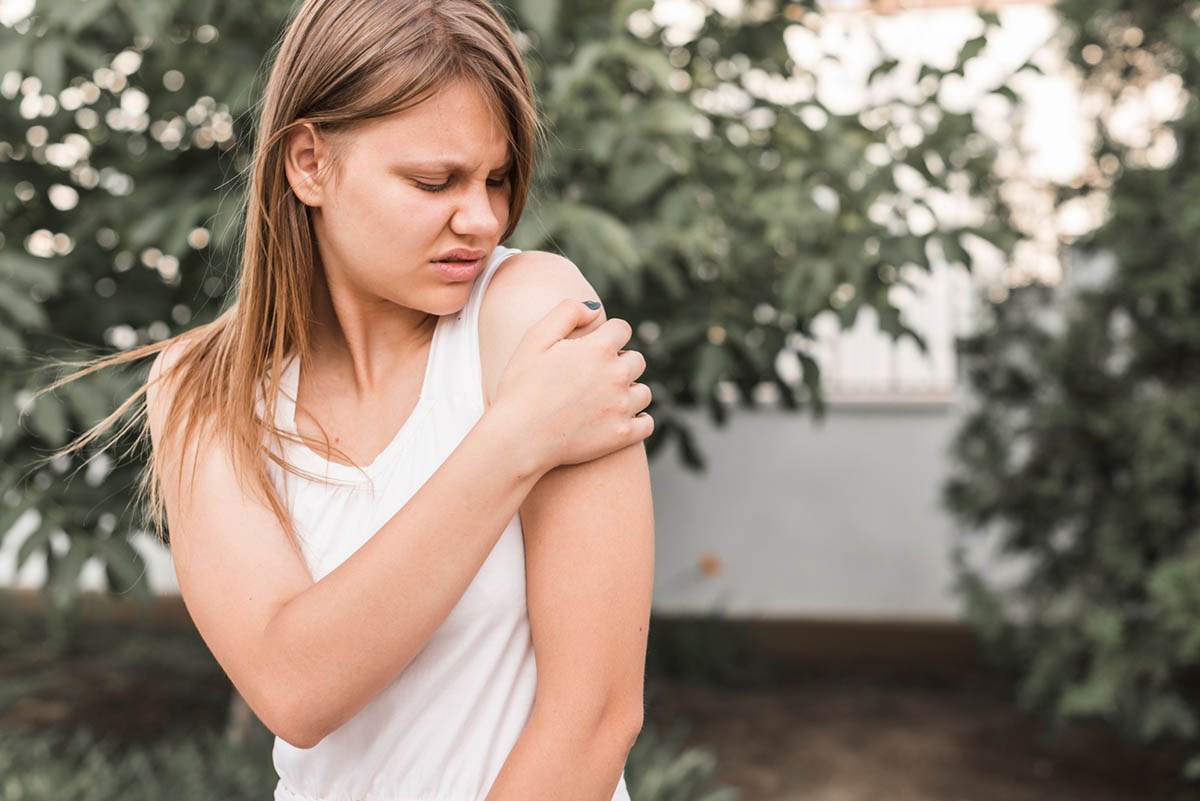An acromioclavicular or AC joint sprain occurs when the ligaments connecting the acromion (part of the shoulder blade) and the clavicle (collar bone) are stretched or torn. Acromioclavicular joint injuries comprise over 40% of all shoulder injuries. While mild injuries typically do not cause significant morbidity, severe injuries can result in considerable loss of shoulder strength and function. This injury commonly results from falls or direct impacts on the shoulder joint, leading to various degrees of pain and dysfunction.
Understanding an AC joint sprain is crucial for proper diagnosis, treatment, and prevention. Awareness helps recognize symptoms early, seek appropriate medical care, and implement strategies to avoid recurrence. Knowledge of AC joint sprain treatment options can significantly improve outcomes and help individuals return to activity sooner.
What are AC Joint Injury Symptoms?
Symptoms of an AC joint injury can vary depending on the severity of the sprain but generally include pain at the top of the shoulder, swelling, bruising, limited shoulder movement, a noticeable bump or deformity on the shoulder, tenderness around the AC joint, and persistent joint pain. These AC joint sprain symptoms can range from mild discomfort to severe pain and functional impairment. Recognizing these symptoms early is crucial for proper diagnosis and treatment, as untreated sprains can lead to chronic issues such as joint instability or arthritis. Understanding the full spectrum of AC joint sprain symptoms can help in seeking timely medical advice and implementing effective treatment strategies.
- Pain at the Top of the Shoulder: Shoulder pain is typically localized to the AC joint. This pain is often sharp and exacerbated by movements involving lifting the arm or carrying heavy objects. It may also radiate down the arm or towards the neck, making it difficult to pinpoint the exact source without a thorough examination.
- Swelling and Bruising: These symptoms often accompany a ligament sprain. Swelling occurs as a result of the body’s inflammatory response to injury, while bruising may appear due to broken blood vessels under the skin. The extent of swelling and bruising can vary based on the severity of the injury, with more significant trauma resulting in more noticeable symptoms.
- Limited Shoulder Movement: Pain and joint disruption can restrict the range of motion. Activities that involve raising the arm, reaching across the body, or performing overhead movements can become particularly challenging. This limitation is due to both the physical damage to the ligaments and the body’s natural response to protect the injured area by forcing you to minimize movement.
- A Noticeable Bump or Deformity on the Shoulder: This is often due to the displacement of the distal clavicle. In more severe AC joint injuries, such as Grade 2 or 3 sprains, the end of the clavicle may protrude upwards, creating a visible and palpable bump. This deformity is a result of the ligaments being unable to hold the clavicle in its normal position.
- Tenderness Around the AC Joint: Touching the affected area causes discomfort. This tenderness is typically concentrated at the top of the shoulder where the acromion meets the clavicle. The pain may increase with pressure, making it difficult to sleep on the injured side or perform activities that require shoulder contact or pressure.
- Joint Pain: Persistent pain may indicate underlying joint arthritis or other complications. Chronic pain following an AC joint sprain can be a sign of more serious issues, such as the development of joint arthritis or ongoing instability in the shoulder joint. This pain can interfere with daily activities and may require more comprehensive treatment to address underlying causes.
Grades of an AC Joint Injury

AC joint injuries are classified into different grades based on the extent of ligament damage and the severity of symptoms. Understanding these grades is essential for determining the appropriate treatment and recovery plan. Each grade reflects a different level of injury, from minor sprains to complete ligament tears, and helps healthcare providers tailor their approach to ensure optimal healing and return to activity.
Grade 1 AC Joint Sprain
A Grade 1 sprain involves minor stretching or partial tearing of the acromioclavicular ligament. Symptoms include mild pain and swelling but no significant deformity. This type of injury is considered a mild sprain and often heals with conservative treatment.
Grade 2 AC Joint Sprain
A Grade 2 sprain indicates a partial tear of the acromioclavicular ligament and potentially the coracoclavicular ligaments, which include the conoid ligament and the trapezoid ligaments. Symptoms are more pronounced with moderate pain, noticeable swelling, and limited shoulder movement. The lateral clavicle may show some degree of displacement, but the ligament remains intact to some extent.
Grade 3 AC Joint Sprain
A Grade 3 sprain is a complete tear of the acromioclavicular and coracoclavicular ligaments, leading to a visible deformity where the collarbone is displaced. Common symptoms include severe pain, significant swelling, and inability to move the shoulder. This severe injury often requires more intensive treatment, possibly including surgical management.
What are the Causes of AC Joint Sprain?
Understanding the causes of AC joint sprains is essential for both prevention and effective treatment. These injuries can result from a variety of factors, including traumatic incidents, repetitive motions, and other underlying conditions. Identifying the specific cause can help tailor the appropriate treatment and preventive measures.
Traumatic Injury
Traumatic injuries are a common cause of AC joint sprains, often resulting from sudden impacts or accidents. These injuries can occur during sports, falls, or direct blows to the shoulder, leading to significant ligament damage.
Falls
Falling onto an outstretched arm or directly onto the shoulder can cause an AC joint sprain. These incidents are common in sports, especially contact sports like football or rugby. The force of the fall can result in joint separation and ligament sprain.
Direct Blows to the Shoulder
A direct impact, such as during a collision in sports or an accident, can force the acromion process downward while the clavicle remains in place, straining or tearing the ligaments. This often leads to superior displacement or posterior displacement of the clavicle.
Overuse Injuries
Overuse injuries develop gradually over time due to repetitive activities that strain the AC joint. Athletes and individuals engaged in activities that involve frequent overhead movements are particularly susceptible to these types of injuries.
Repetitive Motion
Repetitive overhead activities, such as lifting weights or throwing, can stress the AC joint, leading to overuse injuries. Continuous strain on the joint ligaments can result in joint pain and inflammation.
Sports Activities
Athletes engaged in sports that require frequent shoulder movements, like tennis, swimming, or weightlifting, are at higher risk of developing an AC joint sprain from overuse. These athletic activities can lead to distal clavicle osteolysis and joint arthritis over time.
Other Contributing Factors
Several other factors can contribute to the risk of AC joint sprains, including poor posture, previous shoulder injuries, and anatomical abnormalities. Understanding these contributing factors can help in devising comprehensive preventive strategies.
Poor Posture
Poor posture, particularly rounded shoulders or forward head position, can place additional stress on the AC joint, increasing the risk of injury. This can lead to chronic joint pain and the development of arthritis.
Previous Shoulder Injuries
Previous injuries to the shoulder, such as clavicular fractures or shoulder dislocations, can weaken the ligaments and make the AC joint more susceptible to sprains. This includes issues like a frozen shoulder or shoulder separation.
Treatment for AC Joint Sprain
Effective treatment for AC joint sprains depends on the severity of the injury. Treatment options range from conservative measures such as rest and physical therapy to more invasive procedures like surgery. Early and appropriate intervention can significantly enhance recovery and reduce the risk of long-term complications.
Initial Treatment
- Rest and Ice: For all grades, rest and applying ice packs can reduce swelling and pain.
- Pain Relief: Over-the-counter pain medications or prescribed anti-inflammatory drugs can help manage pain and inflammation. Counter-pain medicines are often recommended by healthcare providers.
- Physical Therapy: Physical therapy exercises can improve range of motion, strength, and stability. AC joint sprain exercises focus on restoring shoulder function and preventing stiffness.
- Sling or Brace: A sling or brace may be recommended to immobilize the shoulder, especially for Grade 2 and 3 sprains. This helps in reducing movement and allowing the ligaments to heal.
- Nonsurgical Treatments: Nonsurgical treatments, including physical therapy and medication, are often effective for mild to moderate injuries. Nonoperative treatment is generally the first line of care for less severe injuries.
- Surgical Treatment: In severe cases, particularly Grade 3 sprains, surgical intervention may be required to repair the torn ligaments and restore shoulder function. Surgical management includes ligament reconstruction and joint reconstruction surgery.
How to Prevent AC Joint Injuries

Preventing AC joint injuries involves adopting several proactive measures, including proper technique in physical activities, strength training, and maintaining good posture. By implementing these strategies, individuals can reduce their risk of sustaining an AC joint sprain and maintain optimal shoulder health.
- Proper Technique: Using proper technique in sports and exercise can reduce the risk of injury. This includes proper lifting techniques and avoiding excessive strain on the shoulder joint.
- Strength Training: Strengthening shoulder muscles can provide better support and stability to the joint. Shoulder exercises that target the deltoids, trapezius, and biceps tendon can enhance muscle strength.
- Protective Gear: Wearing appropriate protective gear during contact sports can help prevent direct blows to the shoulder.
- Warm-Up: A thorough warm-up before activities can prepare the shoulder for strenuous movements. Motion exercises can increase blood flow and flexibility in the shoulder complex.
- Posture Correction: Maintaining good posture can reduce undue stress on the AC joint, preventing injuries related to abnormal contact and joint misalignment.
Conclusion
AC joint sprains are common injuries that can range from mild to severe. Understanding the causes, symptoms, and treatment options is essential for effective management and prevention. By taking preventive measures and seeking appropriate treatment, individuals can recover well and reduce the risk of future injuries. Consulting with a healthcare provider or sports medicine specialist can provide tailored advice and innovative treatment plans for optimal management.
At Vitality Therapy & Performance, we specialize in treating a wide range of shoulder injuries, including AC joint sprains, to help you regain strength and functionality. Our expert team provides personalized care for those suffering from shoulder pain, ensuring tailored treatment plans that address your specific needs. Whether you’re dealing with a mild sprain or a severe injury, our comprehensive approach focuses on effective rehabilitation and recovery. We also offer specialized programs for athletes, including those experiencing shoulder impingement in CrossFitters, guiding them back to peak performance with evidence-based therapies and dedicated support.
FAQs
How long does it take for a sprained AC joint to heal?
The healing time for a sprained AC joint varies depending on the severity. A Grade 1 sprain may heal within 2-4 weeks, while a Grade 2 or 3 sprain could take several weeks to months, with more severe cases potentially requiring surgical intervention. Radiographic evaluation by an orthopaedic surgeon can help determine the exact recovery timeline.
Should I stretch a sprained AC joint?
Stretching should be approached cautiously. It’s essential to follow the guidance of a healthcare professional or physical therapist, as inappropriate stretching can exacerbate the injury. Gentle motion exercises may be recommended as part of the rehabilitation process.
Is heat good for AC joint injury?
Heat can help relax and loosen tissues and may be beneficial in the later stages of healing. However, during the initial acute phase, ice is recommended to reduce inflammation and numb the pain. Always consult a healthcare professional for personalized medical advice on using heat or ice for an AC joint sprain.

